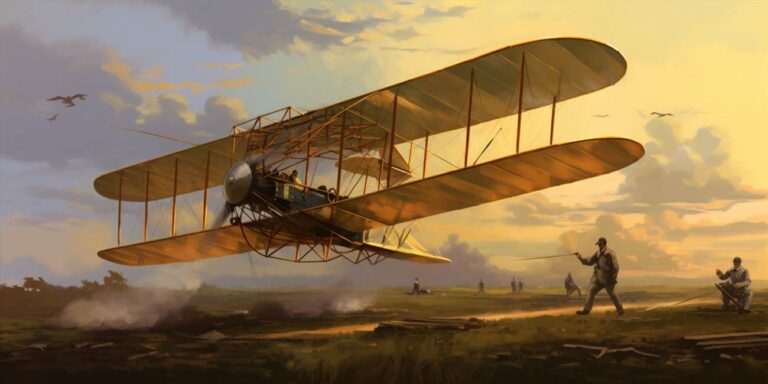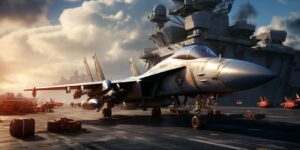The aircraft, with a wingspan of 40 feet and a weight of just over 600 pounds, was a marvel of engineering. It featured a 12-horsepower engine, a modest power source by today’s standards but revolutionary at the time. The engine’s four cylinders roared to life, propelling the biplane into the annals of history.
Orville, positioned at the controls, guided the aircraft down the 60-foot wooden rail that served as a makeshift runway. The winds of Kitty Hawk whispered through the wings as the world held its breath. In a moment that defied centuries of impossibility, the Wright Flyer lifted off the ground, defying gravity and paving the way for the era of powered flight.
Witnessing the historic event were five individuals, including a local teenager and a member of the U.S. Life-Saving Service. The flight lasted 12 seconds, covering a mere 120 feet, but its impact was immeasurable. Humanity had transcended the bonds of terrestrial constraints, soaring into the skies.
The Wright brothers meticulously documented their achievement, capturing the essence of that groundbreaking day. Their innovative wing-warping technology, a precursor to modern ailerons, allowed them to control the aircraft’s roll, proving essential during those crucial seconds in the air.
The key role of the propellers cannot be understated. Designed and carved by the Wright brothers themselves, these wooden wonders provided the necessary thrust for sustained flight. The dual pusher configuration, with the propellers situated behind the wings, minimized aerodynamic disturbances.
As the Wright Flyer touched down, leaving imprints in the sandy landscape, it marked not just the end of a brief journey but the beginning of an aviation revolution. The brothers had unlocked the skies, and the world would never be the same again.
How the wright brothers conducted the first powered flight and paved the way for modern aviation
The Wright Brothers made history on December 17, 1903, by achieving the first powered flight in Kitty Hawk, North Carolina. This groundbreaking event marked the beginning of modern aviation, transforming dreams of human flight into a tangible reality.
Orville and Wilbur Wright were self-taught engineers with a relentless passion for flight. Their journey began with a deep study of the principles of aviation and a critical analysis of existing aeronautical data. Armed with this knowledge, they set out to design and build their own aircraft.
Their first breakthrough came with the development of a three-axis control system that allowed the pilot to maneuver the aircraft effectively. This innovation addressed the challenges of maintaining stability and balance during flight, a key hurdle that had hindered many previous attempts at powered flight.
With the control system in place, the Wright Brothers turned their attention to the engine. They designed and built a lightweight yet powerful internal combustion engine that could propel their aircraft. This engine was a crucial component, providing the necessary thrust for sustained flight.
On the historic day of December 17th, the Wright Brothers took to the skies in their Flyer I, a biplane with a wingspan of 40 feet and a weight of around 605 pounds. The aircraft was positioned on a rail and launched with the help of a catapult, providing the initial acceleration needed for takeoff.
Orville Wright piloted the Flyer I, achieving a flight that lasted a mere 12 seconds but covered a distance of 120 feet. This may seem modest by today’s standards, but it was a monumental achievement at the time. The brothers took turns flying, each attempt refining their understanding of aerodynamics and flight dynamics.
Their groundbreaking success rested not only on technological innovation but also on meticulous testing and experimentation. The Wright Brothers conducted numerous glider tests at Kitty Hawk to gather data on wing shapes, lift, and drag, which informed their design decisions for the powered aircraft.
Their dedication to scientific principles set them apart. Unlike many contemporaries, they focused on gathering empirical data and refining their designs based on real-world observations. This commitment to a scientific approach laid the foundation for the systematic development of aviation technology.
The legacy of the Wright Brothers extends far beyond their historic flight. Their innovations in aircraft design and control systems became the blueprint for subsequent aviators and engineers. Their commitment to sharing knowledge, demonstrated by their refusal to patent their invention, allowed others to build upon their work and accelerate the pace of aviation development.
Significance of achieving stable flight by overcoming lift and drag forces
The significance of achieving stable flight is a complex interplay of various forces and design considerations. One of the fundamental challenges is overcoming the forces of gravity that constantly pull the aircraft towards the Earth. In order to counteract this force, a crucial element is thrust. Without sufficient thrust, the aircraft would be unable to achieve the necessary lift to defy gravity and achieve sustained flight.
Thrust, however, is not the sole determinant of flight. The interaction between airspeed and the aircraft design plays a pivotal role. The aircraft must attain a certain speed relative to the air to generate enough lift to overcome gravity. This necessitates a meticulous consideration of aerodynamics in the wing design. The shape, size, and angle of the wings significantly impact the lift generated, affecting the overall performance of the aircraft.
Moreover, the aircraft’s stability and controllability are critical factors. Achieving a balance between stability and maneuverability is a delicate task in aircraft design. The design must allow the aircraft to maintain a stable attitude during flight, resisting disturbances from external factors such as turbulence, while still providing the necessary control for pilots to navigate effectively.
Understanding and managing drag forces is another essential aspect. Drag opposes the aircraft’s forward motion and is influenced by its shape, surface area, and the airspeed. Efficient aircraft design involves minimizing drag to enhance fuel efficiency and overall performance. This requires careful consideration of the aircraft’s streamlined structure and the materials used in its construction.
Delving deeper into the intricacies of wing design, the aspect ratio, wing loading, and wing sweep all contribute to the aircraft’s aerodynamic efficiency. A higher aspect ratio generally leads to lower drag, while optimal wing loading ensures a balance between lift and weight. The sweep of the wings affects the aircraft’s stability at different speeds, influencing its overall flight characteristics.
Furthermore, advancements in technology continually impact aircraft design, introducing innovations such as winglets to reduce drag and improve fuel efficiency. These elements showcase the dynamic nature of the field, where engineers and designers constantly seek to optimize aircraft performance.
Examining early aircraft designs that set foundation for controllable stable flight
Early in the pursuit of conquering the skies, aviation pioneers laid the foundation for controllable stable flight through ingenious aircraft designs. One such innovation that played a pivotal role was the glider. These rudimentary flying machines, devoid of engines, demonstrated the principles of aerodynamics and stability, setting the stage for the development of powered flight.
The evolution of aircraft control saw the integration of the elevator and rudder, critical components for achieving stability and maneuverability. The elevator, positioned on the tailplane, controls the pitch of the aircraft, allowing it to ascend or descend. Complementing this, the rudder governs the yaw, enabling side-to-side movement.
As aviation progressed, the introduction of the propeller marked a significant leap forward. The propeller, a rotating blade system, harnessed the power of engines to propel aircraft forward. This breakthrough eliminated the reliance on natural forces, empowering pilots to navigate the skies at their discretion.
Mastery over the three primary axes—roll, pitch, and yaw—became a defining feature of controllable flight. The roll, denoting the rotation around the longitudinal axis, allowed for banking and controlled turns. Simultaneously, pitch enabled the alteration of the aircraft’s nose-up or nose-down attitude, crucial for maintaining optimal flight conditions.
Integral to the triumvirate of control surfaces, the yaw axis permitted coordinated turns. Pilots could now execute banked turns with precision, enhancing both the maneuverability and gracefulness of aerial navigation. This pivotal development laid the groundwork for more sophisticated flight techniques and aerial acrobatics.
Ensuring the airworthiness of these early aircraft was a paramount concern. Engineers and aviators tirelessly worked to enhance the structural integrity and safety of these flying machines. The delicate balance between weight, aerodynamics, and structural strength became a focal point, culminating in the establishment of airworthiness standards that persist to this day.






